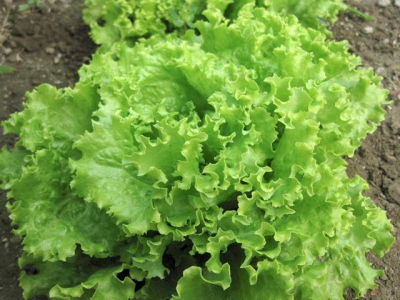How to deal with big-vein virus and tipburn in lettuce

Lettuce big-vein disease is transmitted by the soil-borne fungus (Olpidium brassicae).
A lettuce plant with big-vein virus. The large, light-coloured veins are obvious. Photo: Bill Kerr
The pathogen remains in the soil indefinitely, so crop rotation must be planned carefully, or it will be of little use.
This is a cool-weather disease; I have come across it only in spring, usually in wet conditions in poorly structured sandy soil on a rocky layer, which causes temporary waterlogging.
If the weather is cool at the same time, the fungus comes ‘alive’. The fungus spores germinate into zoospores, which infect the epidermal cells of the roots and introduce the virus into the plant. Symptoms will manifest only about a month later. The disease is easy to identify and is well-described by its common name. The leaves stiffen and the veins turn a light colour and become more pronounced.
Although big-vein virus stays in the land once it is introduced in the soil, all is not lost. Lettuce growers usually plant in rotation, so that infected lands can be planted to another crop in spring and used for lettuce in warm conditions, when the disease will not occur. (When the air temperature rises above 15°C symptoms do not usually appear.)
Lettuce varieties resistant to big-vein virus are available. If so much of the farm is infected that crop rotation does not work, it makes sense to plant one of these varieties.
Tipburn
Tipburn is a calcium deficiency that causes burning of the leaf edges, especially the younger leaves. The deficiency is not necessarily found in the soil, however, and foliar sprays of calcium nitrate are unlikely to help. Rather, it is due to physiological conditions, such as rapid growth and drought stress, that prevent calcium from reaching the leaf edges.
Symptoms will usually be seen on the edges of the inner whorl leaves of young plants, but may be within the heads themselves, and on occasion only detected when the head is opened, much to the ire of customers.
Irrigating at night and during the cool of the day will reduce the likelihood of symptoms appearing. It is in any case highly stressful to a wilting plant to irrigate it in the heat of a hot day. Sometimes, you will find tipburn on the outer leaves as well due to stress. I once had a client who regularly bought ‘complete’ foliar fertiliser mix.
The rep had told him that the mixture would provide every nutrient the crop needed. This advice is nonsense, as it discounts what is already in the soil; if any element is deficient, you should only apply that element.
I advised my client to abandon this practice, but he would nonetheless occasionally spray his crop with this mixture. I could tell when he had done so, as the stress symptoms would reappear! He finally abandoned the practice.
Complications
Other factors can also enter the equation. The necrotic tipburn lesions within a head can lead to soft rot, which makes the problem that far worse. Some lettuce varieties are more tipburn-resistant than others. And certain times of the year are more likely to produce symptoms. Take these into account if you have a persistent problem, and change varieties according to the season.
Related news
Tools

Phối trộn thức ăn chăn nuôi

Pha dung dịch thủy canh

Định mức cho tôm ăn

Phối trộn phân bón NPK

Xác định tỷ lệ tôm sống

Chuyển đổi đơn vị phân bón

Xác định công suất sục khí

Chuyển đổi đơn vị tôm

Tính diện tích nhà kính

Tính thể tích ao



 Hardening vegetable seedlings
Hardening vegetable seedlings  Success with small-scale herb production
Success with small-scale herb production